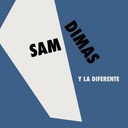TRACKLIST
SIDE A: 1. El Tumbao… - 2. He Sabido Ya De Ti – 3. Quiéreme- Bol. – 4. Se Rompió El Muñeco
SIDE B: 1. Tumba y Quinto – 2. El Vendedor Que No fia – 3. Tus Amores – 4. Canto A Los Niños
DESCRIPTIOON
HIDDEN GEM OF VENEZUELAN SALSA
In the 80s, Dimas “Sam Dimas” Pedroza was encouraged with two atypical projects. One in partnership with the great Larry Francia, another artist released by El Palmas Music, and titled La salsa es con Dimas y Larry. And the other with an orchestra of great artists of the time that El Palmas also proudly relaunches in 2024: Sam Dimas and La Diferente’s El Tumbao…, with songs by prestigious authors such as Joseíto Fernández and José González Giralt and arrangements by the renowned trombonist Rafael Silva.
It is worth mentioning the great musicians that Dimas Pedroza summoned for this album: Rafael Araujo, Lewis Vargas and Gustavo Aranguren (trumpets), Carlos Espinoza and Rafael Silva (trombones), José Ávila (piano), Rafael Prado (bass), Pedro Viloria (timbales, güiro), Williams (congas), Nene Pacheco (bongo, drum), Leo Pacheco, Rafael Silva and Rafael Prado (choirs). There were also some special guests: Alfredo Pollo Gil and Manuel Icazas (trumpets), Oscar Mendoza (trombone), Joe Santamaría and Chucho Chuchochi (timbal) and Edwin Infante (maracas).
Sam Dimas y La Diferente’s El Tumbao… is an album that Dimas - who is 80 years old today and still lives in Caracas - never presented live. One of those hidden gems in the history of salsa that El Palmas is dedicated to rescuing to continue reconstructing the memory of Venezuelan popular music, one of its main objectives. At the time of its appearance it did not receive the attention it deserved, perhaps because at first glance you can only see the surface.
“I met Dimas through Roberto Monserrat on Radio Emisora Venezuela. He was from La Pastora, San José, and worked in a hospital - says Federico Betancourt in the book La salsa de Federico Betancourt y su Combo Latino, published by the Editorial Foundation El perro y la rana -. They invited him to one of the Combo Latino rehearsals and he came. Honestly, at first I was very impressed by the timbre and the way he sang, but Monserrat and the other members of Combo Latino thought it was good and they convinced me to leave him in the group. The day of recording our first LP arrived and I listened to Dimas again and then I said to myself: “Damn, this dude really sings well! You should never get carried away by your first impression.”







